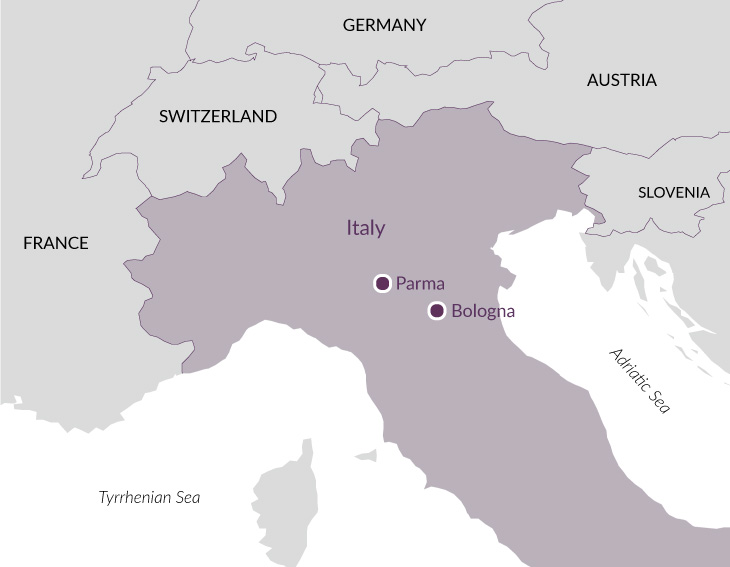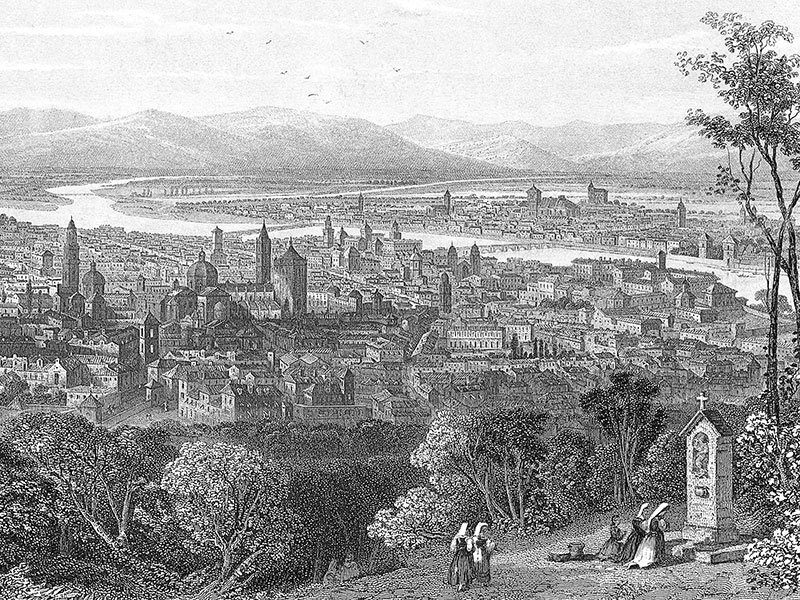Overview
Bound by the River Po to the north and the Apennines to the south, this wedge of Italy is replete with fascinating cities and great works of art, yet is still undeservedly neglected by cultural travellers. With probably not one hundredth of the visitors which Florence and Venice receive and many fewer than, say, Verona or Siena, one can view great architecture and world-class art works without the dispiriting intrusions of a large-scale tourist industry.
Across this undulating plain, one of the most fertile in Italy, the Romans founded a large number of prosperous towns and linked them by the Via Emilia which ran from Milan to the Adriatic coast. In the Middle Ages the region fragmented into a number of independent city states which, whether under a communal or despotic form of government, constructed mighty town halls, vast churches and splendid palaces, and caused great works of art to be created. At the beginning of the modern era, they were parcelled out between a motley collection of usually foreign and invariably unenlightened rulers, and they slumped into a torpor from which they did not recover until the Risorgimento.
Nevertheless, a succession of great artists continued to appear, particularly in sixteenth-century Parma and seventeenth-century Bologna, while the relative lack of prosperity resulted in the preservation of the city centres. One aspect of the allure of Bologna and other towns here is that they successfully reconcile the often incompatible features of economic well-being and ancient, unspoilt and enchantingly picturesque streetscape.
The cities now enjoy an envied reputation within Italy for quality of life and gastronomic excellence. Parma, one of the loveliest of the smaller cities in Italy, has been chosen as the first base for this tour; and Bologna as the second, whose allure lies in the successful reconciliation of features of economic well-being and ancient, unspoilt and enchantingly picturesque streetscape.
Day 1
Piacenza, Parma. Fly at c. 10.30am from London Heathrow to Milan Linate. Drive to Piacenza which, situated on the border of Lombardy, has many mediaeval buildings on its Roman grid plan, among them an outstanding town hall and Romanesque cathedral (exterior only)—from the Renaissance is the equestrian statue of Alessandro Farnese is a masterpiece of Baroque sculpture. First of three nights in Parma.
Day 2
Parma. Parma is of great importance in particular for its High Renaissance school of painting – the cathedral and baptistry are outstanding for their Romanesque architecture and sculpture. By Correggio, we see the astonishingly vital and illusionistic frescoes in the cathedral, the church of S. Giovanni and the exquisite Camera di S. Paolo. In the ducal palace is a good art collection and a rare Renaissance theatre.
Day 3
Fontanellato, Castell’Arquato, Fidenza. Fontanellato is a little town with an enchanting moated castle containing wonderful frescoes by Parmigianino. Drive to Castell’Arquato, a lovely town in the Apennine foothills with a clutch of mediaeval buildings in the central piazza. Continue to Fidenza, which has a beautiful Romanesque cathedral, with excellent sculpture.
Day 4
Torrechiara, Modena. The castle in Torrechiara has 16th-cent. frescoes. Modena has been capital since the 16th cent. of the Este dukedom. The Romanesque cathedral is one of the best in the region, and has marvellous 12th-cent. sculpture by Wiligelmo. Continue to Bologna for the first of three nights.
Day 5
Bologna. One of the most attractive of the larger cities in Italy, with Renaissance arcades flanking the streets. At the mediaeval heart are massive civic buildings and the vast Gothic church of S. Petronio, with sculpture by Jacopo della Quercia, and S. Stefano, a complex of early mediaeval buildings. Free afternoon, or optional visits to the Pinacoteca Nazionale, one of Italy’s finest picture galleries (Raphael, Carracci family, Guido Reni) and S. Domenico, with the tomb of St Dominic.
Day 6
Rimini, Cesena, Faenza. In Rimini visit the outstanding Tempio Malatestiano, designed by Leon Battista Alberti for the tyrant Sigismondo Malatesta, and containing superb decoration by Agostino di Duccio and particularly fine sculptural detail. The Biblioteca Malatestiana in Cesena is a perfectly preserved Renaissance library established by Malatesta Novello, and contains over 300 valuable manuscripts. Return to Bologna via Faenza, to see the neo-classical Palazzo Milzetti, now a regional museum.
Day 7
Bologna. Special arrangement to see the Carracci frescoes in former Palazzo Magnani Salem (subject to confirmation). Fly from Bologna, arriving Heathrow at c. 1.30pm.
Price, per person
Two sharing: £2,120 or £2,010 without flights. Single occupancy: £2,460 or £2,350 without flights.
Included
Flights (Euro Traveller) with British Airways (Airbus 319); travel by private coach; hotel accommodation as described below; breakfasts and 4 dinners with wine, water, coffee; all admissions; all tips; all taxes; the services of the lecturer.
Accommodation
Hotel Stendhal, Parma: a quiet 4-star hotel, the best located in the middle of the historic centre, run by Mercure. Hotel Corona d’Oro, Bologna: an elegant 4-star hotel in the heart of Bologna. Single rooms are doubles for sole use throughout.
How strenuous?
There is a lot of walking on this demanding itinerary and a considerable amount of coach travel. It would not be suitable for anyone who has difficulties with everyday walking or stair-climbing. Average distance by coach per day: 50 miles.
Are you fit enough to join the tour?
Group size
Between 10 and 22 participants.
Travel advice
Before booking, please refer to the FCDO website to ensure you are happy with the travel advice for the destination(s) you are visiting.

